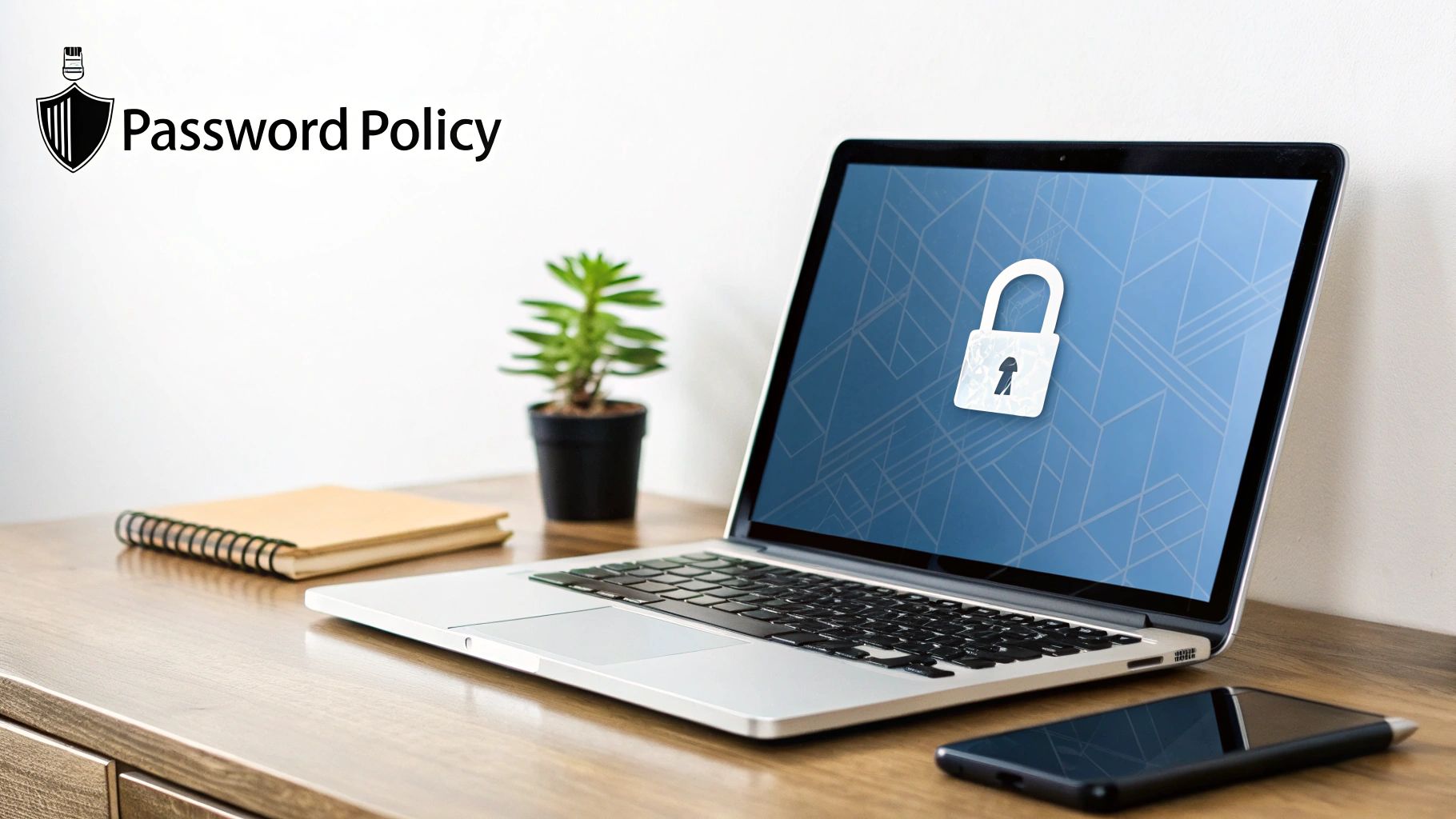
Enterprise Password Security: Proven Strategies
Share
The Reality of Enterprise Password Security Today

Passwords remain a significant vulnerability in enterprise security. Even with considerable cybersecurity investments, many organizations struggle to shield their systems and data from password-related breaches. This raises a crucial question: why do passwords still pose such a problem?
One primary factor is the expanding digital presence of businesses. Employees access numerous applications and services, both on-site and in the cloud, each demanding unique login credentials. This complexity makes effective password management a considerable hurdle. Think about the sheer volume of logins needed for everyday tools like email, CRM systems, project management software, and other crucial platforms.
This complexity often leads to poor password practices. Overwhelmed by the number of accounts they must manage, employees frequently resort to weak, easily guessed passwords. Even worse, they may reuse the same password across multiple platforms. This makes them vulnerable to attackers. The rise of remote work and bring-your-own-device (BYOD) policies adds another layer of complexity, expanding potential entry points for malicious actors.
Common Password Security Challenges
To illustrate the prevalent password security issues affecting businesses today, let's examine the following table:
| Security Challenge | Prevalence (%) (Illustrative) | Risk Level | Mitigation Difficulty |
|---|---|---|---|
| Weak Passwords | 80 | High | Medium |
| Password Reuse | 70 | High | High |
| Phishing Attacks | 60 | Medium | Medium |
| Lack of MFA | 55 | High | Low |
| Inadequate Password Policies | 45 | Medium | Medium |
This table highlights the prevalence and risk associated with common password vulnerabilities. As you can see, weak passwords and password reuse are particularly widespread and pose a high risk. Mitigating these challenges requires a multi-pronged approach.
In 2023, 60% of IT and cybersecurity leaders in the U.S. experienced a cyberattack, underscoring the risks tied to password management. Many organizations still heavily rely on passwords, yet only 46% protect enterprise applications with multi-factor authentication (MFA). Stolen credentials account for over 60% of incidents on platforms like Google Cloud. Despite these challenges, interest in passwordless solutions is growing, with 49% of companies planning to implement this technology. For a deeper dive into password statistics, check out this resource: https://bitwarden.com/blog/a-closer-look-at-password-statistics/
These vulnerabilities are often exploited through tactics like credential stuffing, where attackers test stolen credentials from one platform on other accounts. A single breach can therefore have a domino effect, potentially jeopardizing an entire network. However, forward-thinking organizations are adopting new strategies to address these threats. These strategies include implementing strong password policies, adopting multi-factor authentication, and exploring passwordless login options, reflecting a growing shift towards more secure authentication methods.
Why Password Reuse Is Your Biggest Security Blind Spot

Password reuse is a pervasive problem in enterprise password security. It's like using the same key for your house, car, and office. If someone compromises one, they compromise all. This seemingly harmless habit creates a significant security blind spot, making organizations vulnerable to devastating attacks. But why do even security-conscious employees engage in this risky practice?
One reason is the sheer volume of online accounts modern employees manage. It’s simply easier to remember one or two passwords and reuse them across all accounts. This problem is exacerbated by cognitive overload. When faced with too many complex demands, we naturally gravitate toward simpler, often less secure, solutions.
Remembering dozens of unique, strong passwords feels nearly impossible for most people. So, password reuse becomes the default, the path of least resistance.
The Dangers of Credential Stuffing
This widespread password reuse sets the stage for credential stuffing attacks. These attacks involve malicious actors using lists of compromised usernames and passwords from data breaches. They then systematically test these credentials across various websites and applications.
For example, imagine an employee uses the same password for a personal social media account and their corporate email. A breach of the social media platform hands attackers the key to the corporate network. This single point of failure can lead to disastrous consequences.
Password reuse within the enterprise itself also presents a serious threat. If an attacker compromises one low-level account using a reused password, they might gain access to higher-privileged accounts with the same password. This can enable them to escalate their privileges and cause significant damage, demonstrating the interconnected nature of organizational security.
Real-World Impact: Case Studies
High-profile breaches demonstrate the devastating impact of password reuse. One example involved a major technology company where attackers accessed sensitive customer data through a compromised employee account. The investigation revealed the employee had reused a password previously compromised in an unrelated data breach. This single instance of password reuse cost the company millions in damages and severe reputational harm.
Password reuse mirrors a larger societal trend. Two-thirds of Americans reuse passwords, and over half of U.S. employees admit to the same practice in the workplace. This significantly increases vulnerability to breaches. Alarmingly, over half (56%) of IT professionals endorse SMS-based one-time passwords. While more secure than single-factor authentication, this method still relies on potentially vulnerable channels. Poor passwords contribute to 81% of corporate data breaches, highlighting the urgent need for strong password policies and exploring alternative authentication methods. For more insights, see these password statistics.
Addressing Password Reuse Effectively
Leading organizations proactively address this issue through multi-layered strategies. These include robust password policies, regular security awareness training, and implementing password managers. These tools generate and store strong, unique passwords, simplifying password management for employees and reducing the temptation to reuse credentials.
Organizations are also increasingly adopting multi-factor authentication (MFA) and passwordless solutions. These technologies provide additional layers of security, making it significantly harder for attackers to gain access even if a password is compromised. This shift represents a fundamental change in how organizations approach enterprise password security, acknowledging that passwords alone are no longer sufficient. By combining these strategies, businesses can effectively address the vulnerability of password reuse and bolster their overall security posture.
Creating Password Policies People Actually Follow

Effective enterprise password security relies on policies that are both robust and user-friendly. Often, organizations implement complex password requirements that might seem effective on paper, but ultimately frustrate employees. This can lead to workarounds that compromise security. This section explores practical strategies for crafting password policies that people will actually use, balancing strong security with usability.
Balancing Security and Usability
The core of effective password policies lies in understanding the user experience. Imagine a policy demanding 16-character passwords with uppercase, lowercase, numbers, and symbols, all changed every 30 days. This complexity can overwhelm employees, leading them to write down passwords or use minor variations. These actions negate the security benefits.
Instead, concentrate on essential principles that maximize security without unnecessary complexity. Promote the use of passphrases. Passphrases are longer and easier to remember, and far more difficult to crack than complex passwords. "CorrectHorseBatteryStaple" is a well-known example of a strong passphrase.
Adapting Policies to Risk Levels
Not all accounts require identical security measures. A tiered approach allows you to adjust requirements based on data sensitivity. Accounts with access to sensitive financial information, for example, need stronger protections than those for general company resources. This risk-based approach ensures that critical assets receive the highest level of protection, while less sensitive systems maintain practical security without overwhelming users.
Gaining Employee Buy-In
Password policies only work if employees understand and follow them. Regular security awareness training is essential. Explain the reasons behind the policies, emphasizing real-world consequences of weak passwords. Relatable examples, like credential stuffing attacks, effectively illustrate these risks. This builds a security-conscious culture, where employees actively participate in protecting company data.
Monitoring Compliance and Measuring Effectiveness
Monitoring compliance doesn't necessitate invasive surveillance. Implement password auditing tools like AccountShare to detect weak or reused passwords without revealing the actual passwords themselves. Focus on identifying patterns of risky behavior and provide targeted training.
Go beyond basic compliance metrics. Track the number of password-related security incidents to measure the effectiveness of your policies. A decline in incidents signals that the policies are working. Employee surveys can provide valuable feedback for continuous improvement.
Practical Tips for Effective Password Policies
- Prioritize passphrases: Encourage long, memorable phrases.
- Implement a tiered approach: Adjust policies based on the risk level associated with the data accessed.
- Provide regular training: Educate employees on password best practices.
- Use password managers: Promote the use of tools like AccountShare for secure password management and sharing.
- Monitor and measure: Track compliance and security incident rates to assess policy effectiveness.
- Embrace multi-factor authentication: Add an extra layer of security beyond passwords.
By implementing these strategies, organizations can develop password policies that are secure and user-friendly. This creates a culture of security awareness and reduces the risk of password-related breaches, strengthening the overall enterprise password security posture.
Beyond Passwords: Multi-Factor That Makes Sense

Multi-factor authentication (MFA) significantly bolsters enterprise password security. However, its true effectiveness hinges on thoughtful implementation. Simply adding an extra authentication layer isn't enough. The key is to select and deploy MFA solutions that enhance security without compromising productivity. Let's explore how leading organizations strike this critical balance.
Choosing the Right MFA Approach
Different MFA methods offer varying levels of security and usability. Consider these factors when choosing the best fit for your enterprise:
-
Hardware Tokens: These physical devices generate one-time codes, offering strong security. However, they can be cumbersome for users. Lost tokens can also disrupt access.
-
Software Tokens (Authenticator Apps): These apps generate time-based codes on smartphones. They offer a good balance of security and convenience, and are generally less susceptible to phishing attacks than SMS-based codes. Authy and Google Authenticator are examples of popular authenticator apps.
-
Biometrics: Fingerprint scanning, facial recognition, and other biometric methods offer a user-friendly experience. However, they can raise privacy concerns. They may also be unsuitable for all users or devices.
-
Push Notifications: Users receive a notification on their device and approve or deny the login attempt with a single tap. This is a convenient and secure option.
-
SMS Codes: SMS codes are easy to implement. However, they are vulnerable to SIM swapping attacks and are generally less secure than other methods.
MFA Implementation: Strategies for Success
Successful MFA deployments require a strategic approach:
-
Phased Rollout: Start with a pilot group to test the chosen MFA method and gather feedback. Then, gradually expand the rollout to other departments, allowing time to address any issues.
-
User Training: Educate employees on the importance of MFA and how to use the chosen method. Clear, concise instructions and readily available support are essential for a smooth transition.
-
Integration with Existing Systems: Ensure the MFA solution seamlessly integrates with your current IT infrastructure, including directory services, applications, and VPNs. This minimizes disruption to existing workflows.
-
Account Recovery Options: Establish robust account recovery procedures to help users regain access if they lose their MFA device or have other problems. This prevents lockouts and helps maintain productivity.
Lessons From the Field: Successes and Failures
Learning from both successful and unsuccessful MFA implementations is crucial. One large financial institution successfully implemented MFA across its workforce, which resulted in a significant decrease in account takeover incidents. They achieved this through a combination of user training, a phased rollout, and a user-friendly mobile authenticator app.
In contrast, a retail company experienced significant employee pushback after a poorly planned MFA rollout. The chosen method was cumbersome and inadequate training led to widespread frustration and help desk overload. This highlights the importance of user experience and training.
Enterprise MFA Methods Comparison
To help you choose the right MFA method for your organization, the following table compares various methods based on several key factors.
| MFA Method | Security Level | User Experience | Implementation Complexity | Cost | Best For |
|---|---|---|---|---|---|
| Hardware Tokens | High | Low | Medium | Moderate | High-security environments |
| Software Tokens | Medium-High | High | Low | Low | Most organizations |
| Biometrics | Medium | High | Medium-High | Moderate | User convenience is paramount |
| Push Notifications | Medium-High | High | Low | Low | Balancing security and convenience |
| SMS Codes | Low | Medium | Low | Low | Limited budget, low-risk applications |
By implementing a well-planned MFA strategy and selecting the right technology, organizations can substantially improve their enterprise password security. This proactive approach not only minimizes the risk of breaches but also builds user confidence and cultivates a culture of security awareness. Tools like AccountShare offer secure password management and sharing capabilities. These complement MFA implementation and address key aspects of comprehensive enterprise password security. This combined approach strengthens defenses against increasingly sophisticated threats.
Passwordless Authentication: Reality Vs. Hype
Passwordless authentication is often presented as the next big thing in enterprise security. It promises a world without the weaknesses of traditional passwords, offering better security and a smoother user experience. But how much of this is real progress, and how much is just marketing hype? This section separates fact from fiction, exploring the practical aspects of implementing passwordless authentication in the enterprise.
The Business Case for Passwordless
Besides the clear security advantages, passwordless authentication offers strong business benefits. Think about the considerable costs linked to password resets. IT help desks dedicate countless hours helping employees who have forgotten their passwords. Passwordless authentication can significantly cut these costs, allowing IT teams to focus on more important projects.
Passwordless logins also provide a seamless user experience, boosting productivity. Employees can access their work quickly and easily, avoiding the hassle of forgotten passwords or complicated login processes. These combined benefits create a compelling argument for switching to passwordless, particularly over the long term.
Implementation Challenges and Solutions
While the advantages of passwordless authentication are evident, there are practical hurdles to overcome. Integrating passwordless solutions with older systems can be difficult. Many legacy applications may not be compatible with newer authentication methods, requiring substantial updates or workarounds. Also, transitioning to a passwordless model requires organizational change. Employees need training and assistance to adapt to new login procedures.
But these challenges are not impossible to solve. A gradual implementation approach can minimize disruptions. Start with a pilot program involving a small group of users and progressively expand the rollout as issues are resolved. For instance, begin by implementing passwordless authentication for low-risk applications before moving on to more sensitive systems as confidence increases. Clear communication and detailed training resources are essential for a smooth transition.
Addressing Stakeholder Concerns
Moving to passwordless authentication often means addressing the worries of different stakeholders. Security teams may have concerns about the safety of new authentication methods. IT departments may be anxious about the complexity of integration. And users might be resistant to change. Tackling these concerns directly is crucial for successful adoption.
Open communication and transparency are essential. Clearly explain the security advantages of passwordless authentication, using data and industry best practices as evidence. Show how the chosen solution mitigates potential security risks. Involve IT teams from the outset of the planning phase to ensure smooth integration with current systems. User input is also vital. Run pilot programs and collect feedback to address any usability issues.
The shift to passwordless technology is growing as organizations prioritize stronger enterprise security. In 2023, 43% of IT and cybersecurity leaders in the U.S. replaced traditional passwords with biometrics or passkeys. A notable 87% of IT professionals feel passwordless solutions are essential for enhancing security. This movement toward passwordless authentication is predicted to expand significantly, reaching a market value of $53 billion by 2030. Though there are implementation challenges, the advantages of improved security and reduced friction are propelling adoption. Find more specific statistics here.
Building a Passwordless Roadmap
Transitioning to a passwordless system necessitates a clear roadmap. This roadmap should detail the steps involved in the implementation, including:
- Assessment: Analyze your existing authentication setup and pinpoint areas that need improvement.
- Selection: Select a passwordless solution that meets your security needs and organizational requirements.
- Pilot: Run a pilot program to evaluate the selected solution and gather feedback.
- Rollout: Gradually implement the solution company-wide, addressing any problems as they appear.
- Training: Offer ongoing training and support to employees.
- Monitoring: Continuously track the effectiveness of the solution and adapt it as needed.
You might be interested in: How to Master Account Sharing.
By carefully evaluating these elements and creating a practical implementation strategy, businesses can effectively migrate to a passwordless system, strengthening security and enhancing the user experience. This strategic move acknowledges the shortcomings of traditional password-based security and embraces the potential of more secure and user-friendly authentication methods.
Enterprise Password Managers That Actually Work
Enterprise password security isn't just about strong passwords; it's about managing them efficiently. Password managers offer a solution, but success hinges on choosing the right platform and implementing it effectively. This requires a dedicated effort to encourage user adoption and ongoing maintenance.
Key Features of Effective Enterprise Password Managers
When selecting an enterprise password management solution, prioritize these essential features:
-
Directory Integration: Smooth integration with existing directory services like Active Directory or Azure AD simplifies user provisioning and management. This reduces administrative work and maintains consistent access control.
-
Strong Encryption: Solid encryption, both in transit and at rest, is crucial. Look for AES-256 encryption or similar industry-standard methods to protect credentials.
-
Multi-Factor Authentication (MFA): MFA adds an extra layer of security by requiring multiple forms of identification. This makes unauthorized access much harder, even with a compromised master password.
-
Emergency Access: Secure emergency access protocols are vital. These allow authorized personnel to access crucial accounts in emergencies, preventing disruptions.
-
Password Sharing and Permissions: Controlled password sharing with detailed permissions is essential for team collaboration while maintaining access control.
-
Reporting and Auditing: Comprehensive reporting and auditing features help track password use, spot weak passwords, and monitor overall security.
Deployment and Training: Driving Adoption
Successful deployment goes beyond simply installing the software. Focus on these key areas:
-
Phased Rollout: Start with a pilot group to test and gather feedback before gradually expanding to other departments. This iterative approach allows for addressing issues as they arise.
-
Targeted Training: Provide practical training that highlights the benefits and addresses user concerns. Clearly explain how to use the platform’s features, focusing on the "why" as well as the "how".
-
Ongoing Support: Offer continuous support with accessible documentation, FAQs, and dedicated help channels. This encourages active use and quick problem-solving.
Measuring Security Improvements and ROI
Demonstrate the value of your password manager by focusing on measurable results:
-
Reduced Password-Related Support Tickets: Track the decrease in password reset requests to show direct cost savings.
-
Improved Password Strength: Monitor overall password strength within the system to reveal quantifiable security gains.
-
Faster Incident Response: Track the time taken to resolve security incidents related to compromised accounts. Quicker response times mean a stronger security posture.
-
Decreased Password Reuse: Monitor password reuse rates across the enterprise. Lower rates limit the damage from credential stuffing attacks.
Case Study: Streamlining Secure Access
A mid-sized software company implemented an enterprise password manager across its development teams. By integrating the manager with their directory service, they automated user provisioning. Targeted training addressed developer concerns. Results included a significant drop in support tickets and better password strength, showcasing the benefits of a well-executed implementation. Read also: How to master account sharing.
Choosing the Right Solution for Your Enterprise
Numerous password managers offer varying features. AccountShare, for example, offers a secure platform for managing and sharing credentials within teams, enhancing collaboration and streamlining access. However, it's crucial to evaluate your specific enterprise needs and choose a solution that aligns with your requirements and organizational goals to maximize security and productivity benefits.
Future-Proofing Your Password Security Strategy
Protecting your enterprise's sensitive data requires a proactive, forward-thinking approach to password security. This means anticipating future threats and adapting your strategy to meet them head-on. This section explores emerging trends reshaping enterprise password security and how to prepare your organization for the challenges and opportunities ahead.
The Quantum Computing Conundrum
The arrival of quantum computing presents a significant challenge to current encryption methods. Quantum computers, with their immense processing power, could potentially crack widely used encryption algorithms, rendering many current security measures ineffective. This has serious implications for enterprise password security, as many systems rely on these algorithms to protect sensitive data.
But this doesn't spell the end of security. The cybersecurity community is actively developing quantum-resistant cryptography. These new algorithms are designed to withstand attacks from quantum computers, ensuring data remains secure even in a post-quantum world. Staying informed about these developments and incorporating them into your long-term security strategy is crucial.
For example, start researching and testing quantum-resistant algorithms to understand their implications for your systems. This proactive approach will help you stay ahead of the curve.
AI-Powered Threat Detection
Artificial intelligence (AI) is playing an increasingly important role in cybersecurity. AI-powered tools can analyze massive amounts of data to identify unusual login patterns, detect potential breaches in real-time, and even predict future attacks.
For instance, AI can detect anomalies like login attempts from unusual locations or devices, alerting security teams to potential breaches before they escalate. This proactive approach improves your organization's overall security posture and significantly reduces response times.
Adaptable Authentication Frameworks
Building an adaptable authentication framework is crucial for future-proofing your enterprise password security. This means moving beyond rigid, static policies and embracing more flexible solutions that can evolve with the threat landscape.
Consider implementing solutions that allow you to easily integrate new authentication methods as they become available, without requiring massive system overhauls. This agility is essential for responding to new threats and adapting to evolving security best practices.
Navigating the Evolving Regulatory Landscape
Data privacy and security regulations are constantly changing. Regulations like GDPR and CCPA mandate specific data protection measures, including strong authentication requirements. Keeping up with these changes and ensuring your password security strategy complies with relevant regulations is paramount.
Implementing strong multi-factor authentication (MFA) and data encryption measures can help your organization comply with various data privacy regulations. This not only helps avoid penalties but also builds trust with customers and partners.
Building a Future-Ready Strategy
Preparing for the future of enterprise password security involves a multi-pronged approach:
- Invest in ongoing security awareness training: Educate employees about emerging threats and best practices.
- Embrace a zero-trust model: Verify every user and device attempting to access your network, regardless of location.
- Explore and test new technologies: Stay informed about the latest advancements in authentication and security.
- Develop a robust incident response plan: Prepare for potential breaches and have a clear plan for mitigating damage.
By adopting these strategies, organizations can build a resilient and adaptable password security framework that can withstand future challenges and protect their valuable data.
Ready to take your enterprise password security to the next level? AccountShare offers a secure platform for managing and sharing credentials within teams, enhancing collaboration and streamlining access. Learn more about how AccountShare can help you build a stronger, more efficient security posture: https://accountshare.ai
